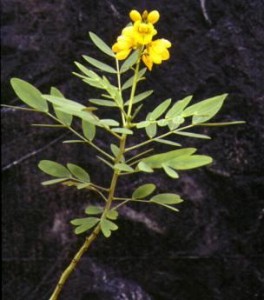 The senna plant is a small shrub in the cassia genus, which belongs to the fabaceae family, and is native to regions of West Asia. These plants are erect, branching shrubs that can reach between 0.70 to 1.00 m in height. They are made up of tiny yellow flowers; smooth, light green stems; and long branches that hold four to five pairs of thick, veiny, apexed leaves which are gray-green on top, and yellow-green at the bottom. This plant contain a wide variety of compounds including monomeric anthraquinones, together with their glycosides and dimeric anthrones glycosides. Sennosides are the purgative principles of this plant and like other glycosides are metabolized by humans into anthraquinones which are the active metabolites.
The senna plant is a small shrub in the cassia genus, which belongs to the fabaceae family, and is native to regions of West Asia. These plants are erect, branching shrubs that can reach between 0.70 to 1.00 m in height. They are made up of tiny yellow flowers; smooth, light green stems; and long branches that hold four to five pairs of thick, veiny, apexed leaves which are gray-green on top, and yellow-green at the bottom. This plant contain a wide variety of compounds including monomeric anthraquinones, together with their glycosides and dimeric anthrones glycosides. Sennosides are the purgative principles of this plant and like other glycosides are metabolized by humans into anthraquinones which are the active metabolites.Senna leaves is used as oriental laxative medicines. This plant contain a wide variety of compounds including monomeric anthraquinones, together with their glycosides and dimeric anthrones glycosides. Sennosides are the purgative principles of this plant and like other glycosides are metabolized by humans into anthraquinones which are the active metabolites.The natural free anthraquinones are not effective and it has been confirmed that they are reduced into anthrones and anthranoles in the human intestine, and act as laxative compounds. The stimulant laxatives composed of the anthraquinones are the cause of the greatest side-effects and are often abused by the public, therefore the identification and analysis of anthraquinones in herbal samples, pharmaceutical preparations and biological fluids are of great importance.
Chemical composition: Contains anthraquinones including dianthrone glycosides (1.5% to 3%), sennosides A and B (rhein dianthrones), sennosides C and D (rhein aloe-emodin heterodianthrones). Numerous minor sennosides have been identified, and all appear to contribute to the laxative effect. The plant also contains free anthroquinones in small amounts including rhein, aloe-emodin, chrysophanol and their glycosides. Senna pods also contain the same rhein dianthrone glycosides as the leaves. Carbohydrates in the plant include 2% polysaccharides, and approximately 10% mucilage consisting of galactose, arabinose, rhamnose and galacturonic acid. Other carbohydrates include mannose, fructose, glucose, pinitol and sucrose. Flavonols present include isorhamnetin and kaempferol. Glycosides 6-hydroxymusizin and tinnevellin are also found. Other constituents in senna include chrysophanic acid, salicylic acid, saponin, resin, mannitol, sodium potassium tartrate and trace amounts of volatile oil.
Note: Senna should not be used by people diverticular disease, ulcerative colitis, Crohn’s disease, severe hemorrhoids, blood vessel disease, congestive heart failure, heart disease, severe anemia, abdominal hernia, gastrointestinal cancer, recent colon surgery, or liver and kidney disease.
Usage: 1 tbls dried senna leaves are boiled in 200-250ml water for 2-3min. After cooling is filtered. Drink twice during a day.
You can order dried Senna leaf from our catalog.
 Български
Български
Leave a Reply to hcg diet Cancel reply